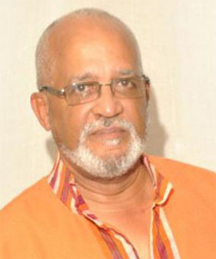In a number of important ways the performance of the GT&T Link Show 29 in February and March of 2013 may be recorded as an achievement, while in a few other areas there are questions and blemishes. Rising above all is the present strength of the Link Show as an annual satirical revue and the fact that it continues a long and noble tradition of satire in Caribbean theatre. Its 29th appearance since 1981 speaks to the survival of a threatened species and in this regard it is surpassed only by the annual Jamaica Pantomime. This factor over-rides the areas of doubt that persist.

As a descendant of Pilgrim’s Brink series, The Link faltered, then soared Phoenix-like from its own ashes to its greatest imperial heights in 2009. That peak was nearly matched in 2010 then scaled off a bit. Number 29 continued the general high level of excellence of production to which the annual series has become accustomed. It was professionally managed with a fluency that kept its brisk pace consistent and allowed it to be played out on sometimes effective set sequences and efficient changes. The attention to costuming was a notable factor, as was make-up at times, particularly when needed to support personality take-off and lampoon.
With that support the acting was uniformly good with several prominent cameos as expected. Most of the performers are well versed in the types of farce required in many skits, and this varied from the occasional bits of high farce to slapstick and some really good camp, particularly from Michael Ignatius. Delivery and timing were generally on target except at the odd times when bad lighting cues spoilt them. Robinson’s direction seemed tight in this kind of multi-faceted production and the cast responded as an organized team of spirited performers.
However, while the actors performed with an understanding of satirical theatre and of their audience, the Director’s Programme Notes, not for the first time, bring into question the purpose of satire. Robinson applies some probable sarcasm in “apologizing” to those persons who actually look forward to being lampooned in the Link, and are disappointed if they are not targeted. It seems those do exist who see the show as a kind of local ‘Who’s Who’ of prominent persons and consider it a compliment to be mentioned – that their inclusion is some recognition that they have arrived. The director treats them in his Notes with a touch of high burlesque, but it was Robinson himself who created those monsters. For many years his comments gave the clear indication that the Link was a social register and that being included was an honour, that lampooning was a form of flattery. He is therefore now satirising his own creations.
He quite correctly observes that “little do some realize that satire is not as easy as it may seem to produce.” And he ought to know. The Link is now quite good machinery for the production of satire, but it only got there after years in the wilderness. The quality of scripts was a weakness in Link Show 28, but that was reversed in Number 29 when they were decidedly better. There was mixed quality, but a significant number of good sequences, particularly in the earlier part of the programme when it had an effective start and the feel of a strong show. There were some very good imaginative ideas for skits with not only a variety, but impressive use of situations within which to locate satire. The Link has learnt to write satire into ordinary comic skits and ‘Quickies.’ A number of ordinary jokes made a comment.
Those are some of the many elements that have to go into producing this kind of theatre. This production also achieved many sharp and unpredictable punch-lines, along with punch-lines that were not passé. The picking of targets is another demanding element. Some Link shows thrive on a main theme – a particular target that becomes a motif, is a popular butt, and is well hammered – often to death. The ‘bobole’ in this show was “the First Lady’s silver shoes.” By curtain time many members of the audience seriously wished she had never worn them.

The picking of targets, then, is important to annual revues of this nature. It is not unusual for the government to be the main target – in fact, that is usually the case. It is common, almost expected, for art to challenge authority, and the government is always the most prominent monadnock stubbornly standing up to be attacked by satirical erosion. They are the most visible in public life; their blunders are perpetually in the news; they are better known than any other agency and become the easiest targets. Besides, what the government does affects everyone. A government cannot be thin-skinned and can always expect public and popular art forms such as calypso and annual revues to attack them.
The Link has always targeted government, and one has sometimes asked, okay, so was the opposition impeccable then? And were all their members always well behaved? Well the balance was better in 2013 when the opposition which had seemed immune these several years came in for quite some attention. This is worth mentioning because satire is not easy to write as Robinson is aware, because of its responsibility. It needs to be able to lampoon without undermining and destablising. It is not difficult to entrench prejudices and inflame dangerous popular sentiments, so satire needs to be conscious since it still seeks to improve.
As it happens, it is on this question of targets that Link Show 29 generated a few doubts. One of the targets that needs to be approached with delicacy, despite the popular temptations, is the treatment of racial minorities. Couple that with immigrant minority communities and you have ready targets for take-off – instant material for comic treatment mainly because they are ethnically different. This is known in literature as ‘Othering’ – when people who are different and who are minorities in a society receive unfavourable or uncomplimentary treatment. Literature is a crucial part of social life and pays attention to such issues.
Literature has condemned this kind of relegation of West Indians, of East Indians and Africans in the United Kingdom, infamous for the bashing of “Pakis.” In the USA, immigrant people known as Latinos have been in similar positions. The Caribbean and the post-colonial literature have been very critical of this ‘othering.’ Historically, it was at its worst in the theatre when it was popular to have “Blackface” performances on Broadway and in American theatre in pre-revolutionary Cuba.

Is there any difference between the situations described in the foregoing and the treatment of the Chinese in the Link Show? Chinese humour, or rather, humour at the expense of the Chinese, has been exceedingly popular in Guyana in recent times, and its presentation was increased in this year’s Link. They have found a great asset in Mark Kazim, an actor who has emerged to perfect Chinese imitations. But it is a temptation that the Link Show needs to be careful about. It carries a danger of entrenching the social ‘othering’ of a minority immigrant community in Guyana and enlarging social prejudice. Potentially it is not good news for race relations. This comment is by no means saying that there must never be any take-off on the Chinese, it is just pointing to the need for greater diplomacy and sensitivity.
Apart from subjects and targets, another vital element of this kind of dramatic presentation is form. Music has always been a part of the Link although its effectiveness has been inconsistent over the years. 2013 was not one of the better ones. Music was one of the weak areas this year. There were drums, a keyboard and an electronic sound-track which somehow combined to produce discordance and overall dubious sound quality. Where the singing was concerned, audibility (clarity) was not of the best and the lyrics were at best lukewarm, with only the odd line or two sounding like wit or sense.
There was clearly a greater role for music in the show which was not fulfilled. This is the age of Caribbean performance with versatility in movement, speech, music and dance. The last of these provoked two comments. The role for dance in satirical theatre has many possibilities through which it can be used creatively for satirical purpose. It can be more than just comic dance if it is integrated into statements. In this case that was not done; it was just generally good choreography. It was an excellent achievement that the entire cast of actors was made to dance competently and it succeeded in lending the show a neat, strong and colourful ending with a choreographed curtain call.
It closed a production in which the very slick use of multi-media enhanced the professional polish. A few skits utilised video projection in a very unobtrusive fashion without missing a step. This surely contributed to the different ideas explored by the GT&T Link Show 29 to diversify the presentation of satirical material, while all the contributing factors served to recommend it to an appreciative and thoroughly entertained audience.





